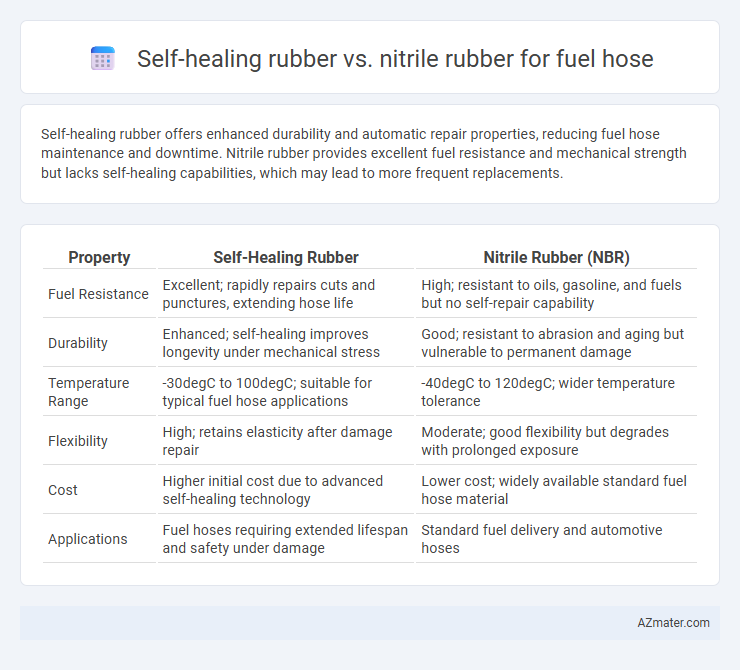Self-healing rubber offers enhanced durability and automatic repair properties, reducing fuel hose maintenance and downtime. Nitrile rubber provides excellent fuel resistance and mechanical strength but lacks self-healing capabilities, which may lead to more frequent replacements.
Table of Comparison
| Property | Self-Healing Rubber | Nitrile Rubber (NBR) |
|---|---|---|
| Fuel Resistance | Excellent; rapidly repairs cuts and punctures, extending hose life | High; resistant to oils, gasoline, and fuels but no self-repair capability |
| Durability | Enhanced; self-healing improves longevity under mechanical stress | Good; resistant to abrasion and aging but vulnerable to permanent damage |
| Temperature Range | -30degC to 100degC; suitable for typical fuel hose applications | -40degC to 120degC; wider temperature tolerance |
| Flexibility | High; retains elasticity after damage repair | Moderate; good flexibility but degrades with prolonged exposure |
| Cost | Higher initial cost due to advanced self-healing technology | Lower cost; widely available standard fuel hose material |
| Applications | Fuel hoses requiring extended lifespan and safety under damage | Standard fuel delivery and automotive hoses |
Introduction to Fuel Hose Materials
Fuel hose materials such as self-healing rubber and nitrile rubber are critical for ensuring durability and safety in automotive and industrial applications. Self-healing rubber offers innovative properties by automatically repairing minor damages, enhancing hose lifespan and reducing maintenance costs. Nitrile rubber, known for its excellent oil and fuel resistance, provides robust performance under harsh operating conditions, making it a trusted choice for fuel hose manufacturing.
Overview of Self-Healing Rubber Technology
Self-healing rubber technology for fuel hoses employs microcapsules or dynamic covalent bonds to automatically repair damage, enhancing durability and extending hose lifespan. Unlike nitrile rubber, which is prized for its excellent fuel and oil resistance, self-healing rubber offers the added advantage of recovering from punctures and cracks, reducing maintenance frequency. This innovation is particularly beneficial in automotive and industrial applications where fuel hose integrity is critical for safety and performance.
Key Properties of Nitrile Rubber
Nitrile rubber features exceptional oil and fuel resistance, making it ideal for fuel hose applications exposed to hydrocarbons and petroleum-based fluids. Its high tensile strength and excellent abrasion resistance ensure durability under mechanical stress, while maintaining flexibility across a wide temperature range from -40degC to 120degC. Self-healing rubber offers innovative repair capabilities but typically lacks the proven chemical and thermal stability that nitrile rubber provides in demanding fuel hose environments.
Chemical Resistance: Self-Healing vs Nitrile Rubber
Self-healing rubber exhibits moderate chemical resistance with the ability to repair minor damage, enhancing durability in dynamic fuel hose applications. Nitrile rubber demonstrates superior chemical resistance against petroleum-based fuels, oils, and hydrocarbons, making it a preferred choice for fuel hoses exposed to harsh chemical environments. The self-healing capability of certain elastomers adds lifecycle benefits but may not match nitrile's resistance to aggressive fuels and solvents.
Durability and Longevity Comparison
Self-healing rubber exhibits superior durability for fuel hoses by automatically repairing micro-cracks, significantly extending the material's operational lifespan compared to conventional nitrile rubber, which is prone to degradation from constant fuel exposure. Nitrile rubber, while resistant to oil and fuel, demonstrates reduced longevity due to cumulative wear and crack propagation without self-repair mechanisms. The advanced self-healing properties reduce maintenance frequency and improve fuel hose reliability in harsh environments.
Performance Under Pressure and Temperature
Self-healing rubber exhibits superior performance under pressure by autonomously repairing micro-cracks, enhancing durability and leak resistance in fuel hoses exposed to high stress. Nitrile rubber offers excellent resistance to fuel oils and moderate temperature stability, typically withstanding temperatures from -40degC to 120degC, whereas self-healing rubber materials can endure a wider range of thermal fluctuations with improved recovery from thermal-induced damage. The self-healing capability significantly reduces maintenance frequency, making it advantageous for fuel hoses subject to cyclic pressure and temperature variations.
Repair and Maintenance Requirements
Self-healing rubber for fuel hoses significantly reduces repair and maintenance requirements by autonomously sealing small punctures and cracks, minimizing downtime and extending hose lifespan. In contrast, nitrile rubber, while resistant to fuel and oil, requires regular inspections and manual repairs to address wear and leaks, leading to higher maintenance costs and potential service interruptions. Choosing self-healing rubber can enhance operational efficiency and lower long-term maintenance expenses in fuel hose applications.
Environmental Impact and Sustainability
Self-healing rubber for fuel hoses offers significant environmental benefits by reducing material waste and extending product lifespan compared to traditional nitrile rubber, which often requires frequent replacements due to wear and tear. Nitrile rubber, derived from synthetic polymers with petrochemical origins, has a larger carbon footprint and limited recyclability, whereas self-healing materials integrate innovative chemistry that enables autonomous repair, decreasing the need for resource-intensive manufacturing. Sustainable fuel hose applications increasingly favor self-healing rubber for its potential to minimize ecological impact and support circular economy principles through enhanced durability and reduced disposal rates.
Cost Analysis: Initial and Long-term Investment
Self-healing rubber typically has a higher initial cost compared to nitrile rubber due to advanced materials and technology integration, but it offers significant long-term savings through reduced maintenance and extended hose lifespan in fuel applications. Nitrile rubber, while more affordable upfront, often incurs higher replacement and repair expenses over time due to its susceptibility to degradation from fuel exposure and mechanical stress. Evaluating total cost of ownership, self-healing rubber can deliver better value by minimizing downtime and maintenance costs in fuel hose systems.
Suitability for Fuel Hose Applications
Self-healing rubber exhibits excellent resilience and damage recovery properties, making it highly suitable for fuel hose applications exposed to dynamic stress and micro-damage. Nitrile rubber offers superior chemical resistance to fuels and oils, ensuring durability and long service life in fuel hose environments. For fuel hose applications demanding both mechanical toughness and rapid recovery from wear, self-healing rubber provides an innovative advantage, while nitrile rubber remains the industry standard for robust fuel compatibility.

Infographic: Self-healing rubber vs Nitrile rubber for Fuel hose
 azmater.com
azmater.com